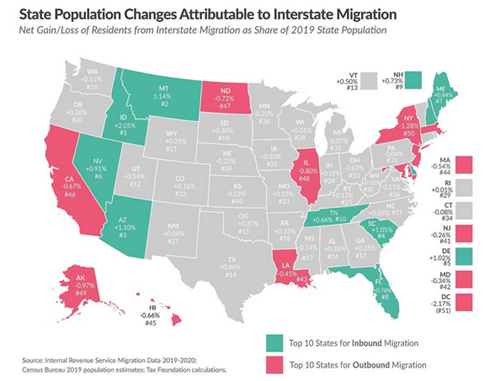Do state/city/local taxes impact interstate migration?
Posted By RichC on October 18, 2022
As a former GOP VP hopeful would say, “You betcha.”
In catching up on my Tax Foundation reading, one of their recent emails highlighted what internationally we have seen in off and onshoring is that businesses go to where they are treated best. It most often has to do with a companies lowest cost of doing business which includes the tax bite where they chose to locate.
Individuals are no different … especially with remote working arrangements, pandemic shutdowns, economic bust and boom cycles and avoiding the heavy hand of local and state government, from restricting personal freedom to taxation; it sure looks to impact interstate migration.
A glance at this 2019 state population map in a Tax Foundation article by Katherine Loughead, highlights a trend. “Americans pack up and move from one state to another.” Each year the IRS releases migration data showing movements of income taxpayers based on changes in their mailing address and data highlights what most of us instinctively know: People prefer lower taxes and less bureaucratic intrusion in their lives.
More Americans Moved to States with Lower Taxes and Sound Tax Structures
With this in mind, one observation from the 2019-2020 IRS migration data is that a strong positive relationship exists between state tax competitiveness and inbound migration. Overall, states with lower taxes and sound tax structures experienced stronger inbound migration than states with higher taxes and more burdensome structures.
Of the 10 states that experienced the largest gains in income taxpayers, five do not levy individual income taxes on wage or salary income at all, and two others had top marginal individual income tax rates that were below the national median at the time. Recently, those states have grown even more competitive. Nine of the top 10 states either forgo individual income taxes on wage and salary income, have a flat income tax, or are moving to a flat income tax.
Additionally, among the 28 states that experienced net inbound migration of income tax filers, only nine had a top marginal individual income tax rate above the national median. Meanwhile, among the 22 states (and the District of Columbia) that experienced net outbound migration of income tax filers, 15 states and D.C. had top marginal rates above the median. In the aggregate, states with a top marginal rate at or below the 2019 median of 5.4 percent gained 225,000 net new residents from the states with rates above the median.
A robust positive relationship also exists between states with below-average state and local tax collections per capita and those experiencing strong inbound migration. Of the 28 states that saw a net gain in income tax filers due to interstate migration, 22 had below-average state and local tax collections per capita in fiscal year 2020, while half of the states that experienced net outbound migration had above-average collections per capita.
Furthermore, a strong positive relationship exists between states with well-structured tax codes and those that experience net inbound migration. Among the 25 best ranking states on the 2020 State Business Tax Climate Index, which had a snapshot date of July 1, 2019, 20 states experienced net inbound migration between 2019 and 2020. Meanwhile, among the 25 worst ranking states on the Index, 17 experienced a net loss of taxpayers to interstate migration.

Comments